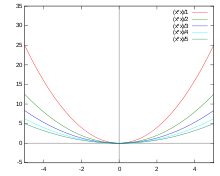Sequence
In mathematics, a sequence is a list (family) of finitely or infinitely many consecutively numbered objects (for example, numbers). The same object can occur several times in a sequence. The object with the number 



If 



Examples





Notation
In general, for a finite sequence writes 





The difference from the set of sequence members 


Example: the sequence (0, 1, 0, 2, 0, 4, 0, 8, ...) has the image set (or underlying set) {0, 1, 2, 4, 8, ...}. The sequence (1, 0, 2, 0, 0, 4, 0, 0, 0, 8, ...) has the same image set. In both sequences the value 0 occurs several times.
Questions and Answers
Q: What is a sequence?
A: A sequence is a set of related events, movements or items that follow each other in a particular order.
Q: How is it used?
A: It is used in mathematics and other disciplines. In ordinary use, it means a series of events, one following another.
Q: What are two kinds of sequences?
A: The two kinds of sequences are finite sequences, which have an end, and infinite sequences, which never end.
Q: Can you give an example of an infinite sequence?
A: An example of an infinite sequence is the sequence of all even numbers bigger than 0. This sequence never ends; it starts with 2, 4, 6 and so on.
Q: How can we write down an infinite sequence?
A: We can write down an infinite sequence by writing a rule for finding the thing in any place one wants. The rule should tell us how to get the thing in the n-th place where n can be any natural number.
Q: What does (a_n) stand for when writing down a sequence?
A:(a_n) stands for the n-th term of the sequence.
Search within the encyclopedia

